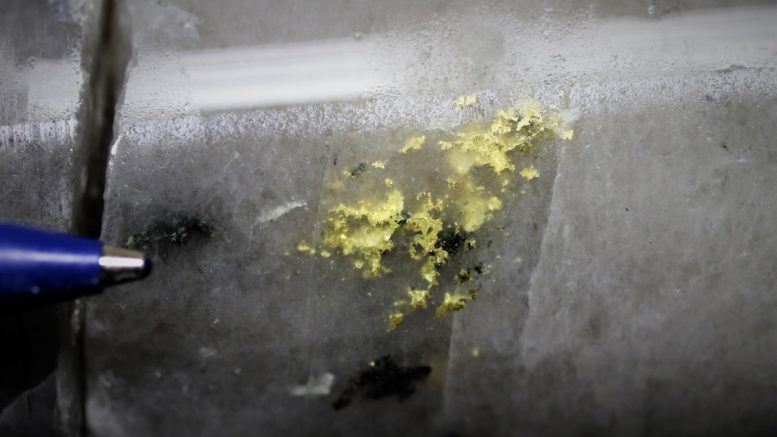Great Bear Royalties (TSXV: GBRR), which was spun out of Great Bear Resources (TSXV: GBR; US-OTC: GTBAF) in January 2020 and listed in April 2021, has “one of the top 20 gold royalty assets in our coverage universe,” according to Canaccord Genuity mining analyst Carey MacRury.
The precious metals royalty and streaming company has a 2% net smelter return (NSR) royalty on Great Bear Resources’ Dixie gold project in northern Ontario’s Red Lake camp, and MacRury initiated coverage of the junior this week with a speculative buy rating and a target price on the stock of $5.00 per share. The company currently trades at $3.85 per share and since listing on the TSX Venture has ranged between a low of $2.49 and $5.00 per share.
MacRury pointed out in an Aug. 23 research note that the Dixie royalty is the junior’s only asset, but that the perpetual royalty is uncapped and has no buyback options. He also noted that Great Bear Resources has completed about 283,000 metres of drilling (630 holes) since 2017 at Dixie and is in the midst of a 175,000-metre ($45 million) drill program this year.
“In our view, the market has increasingly been pricing in a significant emerging discovery,” MacRury wrote, “with Great Bear Resources’ share price up ~ 29 times in the past three years to a market cap of ~$800 million.”
Great Bear Resources is on track to complete its first resource estimate on the project in the first quarter of next year, which will be followed by a preliminary economic assessment on the project, the mining analyst noted.
Great Bear Royalties’ NSR covers the entire 9,140 hectare property package, less than 5% of which has been explored so far, the royalty company outlines in its August corporate presentation.

Drilling at Great Bear Resources’ Dixie project in Ontario’s Red Lake district. Credit: Great Bear Resources
The Dixie project, about 25 km southeast of the town of Red Lake, is described by the company as a “discovery with Tier 1 potential” and is the target of one of the largest exploration programs in Canada.
“Royalties/Streams on Tier 1 assets are very rare and extremely valuable,” the company states in its presentation.
According to MacRury, the initial resource will likely be limited to the first 450 metres from surface of the deposit’s LP Fault Zone, “although it remains open at depth (with mineralization intersected up to 800 metres at depth), and is expected to be subsequently explored.”
“We model a base case [and after-tax] NPV5% [net present value at a 5% discount rate] for Great Bear Royalties’ royalty of $96.5 million (Price/Net Asset Value of 1.1 times) based on a 6 million oz. resource,” he writes, noting that the estimate was based on a long-term gold price assumption of US$1,848 per ounce.
“At a fully ramped production rate of ~376 million oz. a year, we estimate that the royalty should generate average annual royalty revenue to Great Bear Royalties of ~$17 million a year (~7,500 oz. of gold to Great Bear Royalties),” he noted. “And as a royalty company, Great Bear Royalties has exposure to the resource and production potential of the Dixie project but without any obligation for capital or operating costs.”
Great Bear Royalties also has an experienced management team, the analyst noted, with John Robins as CEO. Robins founded Kaminak Gold, which was acquired by Goldcorp in 2016 for $520 million, and also co-founded the Discovery Group of companies in 2005, which includes Bluestone Resources (TSXV: BSR; US-OTC: BBSRF), Fireweed Zinc (TSXV: FWZ) and until a few years ago, Northern Empire. (Northern Empire was sold to Coeur Mining (NYSE: CDE) in 2018).
“There are precious metal streams with values that extend to >$1 billion and are exclusively in the hands of the Big 3 royalty/streaming companies (that is, Franco-Nevada, Wheaton Precious Metals and Royal Gold),” MacRury noted. “That said, we rank the Dixie royalty as one of the top 20 primary gold royalties in our coverage universe and potentially among the top 10 if discounted to 2028, instead of to 2021 (we assume initial production in 2028). Of these top 20, the vast majority are held by the Big 3 or the mid-tier royalty/streaming companies (Osisko Gold Royalties and Sandstorm); none is held by any of the newer junior royalty companies such as Maverix Metals or Nomad.”
The mineralization at Dixie consists of high-grade gold in quartz veins and silica-sulphide replacement zones (the Dixie Limb and Hinge zones) and high-grade disseminated gold with broad moderate to lower grade envelopes, Great Bear Resources says.
On August 25 the company released its latest batch of assay results, with highlights of 28.18 grams gold per tonne over 4.80 metres and 64.30 grams gold per tonne over 0.55 metre.


Be the first to comment on "Single asset Great Bear Royalties moves into the spotlight"